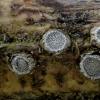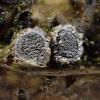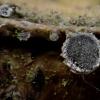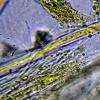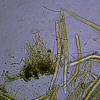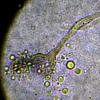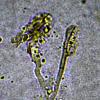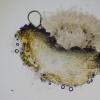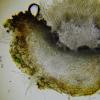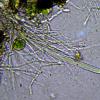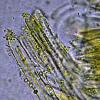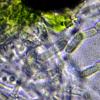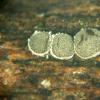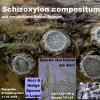
20-12-2025 23:08
Patrice TANCHAUDBonsoir, récolte sur sol sablonneux dans l'arri�

21-12-2025 09:32
Hello.A tiny ascomycete found embedded in wood in

20-12-2025 15:47
Mirek GrycHi.These grew on pine wood that was heavily covere

18-12-2025 21:17
Pol DebaenstThe identification took me to Byssonectria deformi

15-12-2025 07:09
 Danny Newman
Danny Newman
indet. Rutstroemiaceae sp. on unk. fallen leavesMc

19-12-2025 10:10
Patrice TANCHAUDBonjour, récolte réalisée en milieu dunaire, a

18-12-2025 17:23
 Bruno Coué
Bruno Coué
Bonjour,je serais heureux d'avoir votre avis sur c
Unknown finding on Rubus
Christopher Engelhardt,
16-03-2018 14:14
 Hi,
Hi,these grow on what I think to be old & dry Rubus twigs. Asci 150-200 µ long. J-. Some free spores around looking like secondary or conidial spores 6-7,5 x 2 µ, hyaline (not 100% sure that they belong to this fungus). No single spores to be seen in the Ascus, but perhaps Asci full of tiny spores like in Tympanis? Taje a look at the pics, pls.
Any idea appreciated. Thank you!
Chris
Pascal RIBOLLET,
16-03-2018 14:49
Re : Unknown finding on Rubus
Hi Chris,
This looks like the genus Schizoxylon...
Pascal
This looks like the genus Schizoxylon...
Pascal
Hans-Otto Baral,
16-03-2018 15:40

Re : Unknown finding on Rubus
Yes, this might be true. or Stictis. You should study the fungus in water, and perhaps you need to keep it moist for some time to get it more mature.
Did you test in Lugol or Melzer? Usually Stictidaceae have a hemiamyloid hymenium, but not always.
A section showing the margin would be important. Art there many crystals?
Zotto
Did you test in Lugol or Melzer? Usually Stictidaceae have a hemiamyloid hymenium, but not always.
A section showing the margin would be important. Art there many crystals?
Zotto
Christopher Engelhardt,
16-03-2018 17:22

Re : Unknown finding on Rubus
Thank you.
Yes, Zotto, the last two photographs of my first series of pics are in Lugol. That's why they're looking so yellow...
here are some more pics. If I interpret correctly, some (not all) of the paraphyses are branched (first two pics of this series). I have made a section of the margin, which I show on these pics, without and with Lugol. The asci are often accompanied by lots of little droplets, or are they crystals? And on other pic you see some of the "conidia-like" spores mentioned above, 6-8 x 2 µ.
Any more comments very apprediated. Thank you!!
Chris
Yes, Zotto, the last two photographs of my first series of pics are in Lugol. That's why they're looking so yellow...
here are some more pics. If I interpret correctly, some (not all) of the paraphyses are branched (first two pics of this series). I have made a section of the margin, which I show on these pics, without and with Lugol. The asci are often accompanied by lots of little droplets, or are they crystals? And on other pic you see some of the "conidia-like" spores mentioned above, 6-8 x 2 µ.
Any more comments very apprediated. Thank you!!
Chris
Hans-Otto Baral,
16-03-2018 18:32

Re : Unknown finding on Rubus
The "conidia" could well be fragmented part spores, which are usually abundant within the asci.
The granules look more like exudate than crystals. Stictis ha soften a very thick, protruding margin full of large crystals, unlike here.
For a better view you should try oil immersion for the margin. But your contrast is too high to see something in a section I fear.
Yes, Lugol it looks like. Melzer's looks more clean usually.
The granules look more like exudate than crystals. Stictis ha soften a very thick, protruding margin full of large crystals, unlike here.
For a better view you should try oil immersion for the margin. But your contrast is too high to see something in a section I fear.
Yes, Lugol it looks like. Melzer's looks more clean usually.
Bernard Declercq,
18-03-2018 15:31

Re : Unknown finding on Rubus
HI Zotto and Christopher,
At first sight I would say Schizoxylon compositum, a species occurring on all kind of woody substrates, collected here in Belgium on Cornus, Humulus, Rubus, etc.
Syn.: S. ligustri
The spores disarticulate in partspores 3-9x2,5-3 µm, what apparently has been observed here as "conidia".
Bernard
At first sight I would say Schizoxylon compositum, a species occurring on all kind of woody substrates, collected here in Belgium on Cornus, Humulus, Rubus, etc.
Syn.: S. ligustri
The spores disarticulate in partspores 3-9x2,5-3 µm, what apparently has been observed here as "conidia".
Bernard
Hans-Otto Baral,
18-03-2018 16:23

Re : Unknown finding on Rubus
Hi Bernard & Christoph
indeed there was a thread from 2013 of something that looks just like this one:
http://www.ascofrance.com/search_forum/22389
You Bernard say their that S. compositum is a fairly common species in North America following Sherwood, but you don't know if it was recorded in Europe.
Now I suppose that my folder "inamyloid" contains various samples of the same fungus. I renamed it now to "compositum inamyloid2" for the time being.
Zotto
indeed there was a thread from 2013 of something that looks just like this one:
http://www.ascofrance.com/search_forum/22389
You Bernard say their that S. compositum is a fairly common species in North America following Sherwood, but you don't know if it was recorded in Europe.
Now I suppose that my folder "inamyloid" contains various samples of the same fungus. I renamed it now to "compositum inamyloid2" for the time being.
Zotto
Bernard Declercq,
19-03-2018 10:31

Re : Unknown finding on Rubus
No, Zotto, I was speaking of Belgian collections and Belgium is still part of Europe (and I hope it will remain so, we feel very comfortable with Germany as big neighbour).
Herewith a photo of a Belgian Shizophylum compositum collected on Humulus.
My collections have IKI- asci.
Bernard
Herewith a photo of a Belgian Shizophylum compositum collected on Humulus.
My collections have IKI- asci.
Bernard
Hans-Otto Baral,
19-03-2018 10:47

Re : Unknown finding on Rubus
Seems I was not precise, of course I meant Sherwood's statement on the frequency, and your uncertainty about whether European samples are the same species.
Yes, I confirm that this species is totally inamyloid, unlike other Schizoxylon species.
Zotto
Yes, I confirm that this species is totally inamyloid, unlike other Schizoxylon species.
Zotto
Christopher Engelhardt,
19-03-2018 18:15

Re : Unknown finding on Rubus
Thanks Bernard and Zotto for this interesting discussion.
According to what could be seen I now would - carefully - label this as S. compositum: Asci 160-190 x 7-12 µ, Ascospores much shorter (70-125 µ), part-spores cylindrical and ~3 µ broad, margin brownish, paraphyses branched, no J reaction.
Best wishes,
Chris
According to what could be seen I now would - carefully - label this as S. compositum: Asci 160-190 x 7-12 µ, Ascospores much shorter (70-125 µ), part-spores cylindrical and ~3 µ broad, margin brownish, paraphyses branched, no J reaction.
Best wishes,
Chris

